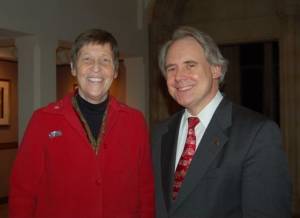Return to Gwyneth Walker Music Catalog
Download an MP3 file of a performance of this work (SATB brass version) by the Cathedral Choral Society, J. Reilly Lewis, director
Download an MP3 file of a performance of this work (SSA organ version) by Kearney Converse, mezzo-soprano and the Tapestry Women's Choir, Dale Forrey, conductor.
Download a PDF file of the text used in this work as text for printing in concert programs.
(Photograph of Gwyneth Walker and music director of the Cathedral Choral Society, J. Reilly Lewis.)

Commissioned by the Cathedral Choral Society, Washington National Cathedral, Washington, D.C., USA, J. Reilly Lewis, music director; made possible by the Richard Wayne Dirksen Memorial Endowment Fund.
My Beloved Son combines two contrasting texts, each portraying the birth of Jesus. The hymn text, "Come, Thou Long-Expected Jesus," by Charles Wesley (1707-1788) is written from an objective viewpoint. The author speaks to Christ, and about Christ:
Come, thou long-expected Jesus, born to set thy people free;
From our fears and sins release us; let us find our rest in thee.
In contrast, the poetry of Hildegard of Bingen (1098-1179), in new translations by Christopher Brunelle, expresses the voice of Mary. This is subjective writing:
Such knowledge is too wonderful for me:
The form of a woman was lowly,
But it welcomed a King.
The Wesley text and poetry of Hildegard are interwoven to create a juxtaposition of the objective and subjective expressions, an alternation between personal and descriptive language. The hymn verses are sung by the full choir, whereas the Hildegard lyrics are presented by a Mezzo soloist. The hymn sections are in strict 4/4 meter. The solo passages are often in free recitative. Hymn material is homophonic in rhythm. The poetic material is contrapuntal. Christ is viewed as the Savior, coming from afar. Or, Jesus is the Beloved Son, "my son, whom I made in my womb."
The climax of the anthem arrives with the fourth verse of the hymn lyrics, "By thine own eternal Spirit..." In this section, the two contrasting "messages" of this anthem, the objective and subjective, are now superimposed. For, all of the men's voices sing the hymn material, while the women sing the very subjective "My Son, my Son..."
The anthem ends softly, bringing a return to the opening hymn verse, "Come, thou long-expected Jesus," sung by the entire choir, with the solo voice of Mary floating above: "Such knowledge is too wonderful for me."
Notes by the composer